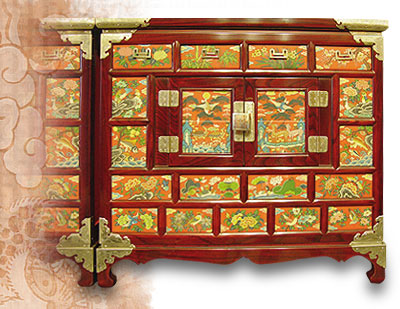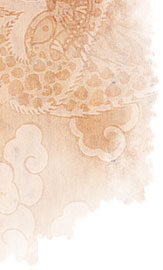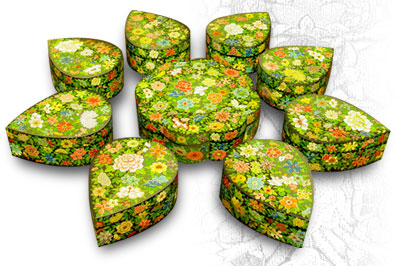Hwagak, literally ‘brilliant horn,’ is the traditional art of inlaying ox-horn pieces, which have been flattened paper-thin and painted, onto the surfaces of furniture and household objects to create vivid intricate designs. Unlike many other Korean arts, for which subdued colors are preferred, the remaining Hwagak artworks today display brilliant colors. They also exhibit a great variety of motifs, including sipjangsaeng (‘10 creatures of longevity’), dragons, phoenixes, magpies and tigers, as well as sagunja (‘four noble beings’) and hwajo (‘flowers and birds’). The items decorated with Hwagak patterns range from large furniture such as wardrobes, cabinets and chests of drawers to small objects, including jewelry boxes, vanity chests, workbaskets, combs, rulers, and spools. Traditionally used to decorate mainly women’s personal belongings, the Hwagak art developed solely in Korea. Art historians believe that Hwagak began to evolve in the early Goryeo Dynasty (918-1392), although the root of its many techniques can be traced further back to more than 1000 years ago. The turtle-shell craft, in which colors are applied to the back of pre-treated turtle-shell pieces so that they are discernible through to the foreground, was introduced to Korea from the Tang Dynasty of China during the Unified Silla Period (668-935). However, the art is known to have originated from ancient Egypt, where people painted the surface of a mummy’s casket then placed transparent or semi-transparent materials such as turtle shells, crystals and embers over top so that the paintings were visible through them. Once the turtle-shell art arrived in Korea, it began to develop in a different way during the Goryeo Period, and was often intermixed with the art of mother-of-pearl inlaying that had already been in the stages of perfection by Goryeo artisans. The turtle-shell craft migrated to other Asian countries, too, but it failed to develop in most of these nations because of the lack of local raw materials as well as the creativity of their respective artists. Fortunately, however, the art survived and thrived in the Goryeo Dynasty because the Korean artisans found a new material, ox horn, which could replace turtle shell, a material that was extremely difficult to acquire. The ox-horn craft evolved further during the Joseon Dynasty (1392-1910), eventually being produced exclusively for the Joseon’s ruling class including its royal households, as mother-of-pearl inlaying had done in the Goryeo Dynasty. This was because the use of dangchae (‘colors of Tang’), a pigment utilized to color ox-horn pieces, had been prohibited since the Silla Period except for use by royalty. The common people were also banned from using another key material for the art―turtle shell―because the shell had to be imported from overseas and naturally was very rare and expensive. Even its substitution, ox horn, could not be obtained easily by the masses because of its great demand for making ‘horn bow,’ an important weapon of the Joseon Period. Ox-horn art continued to survive for a handful of families in the Joseon Dynasty’s ruling class until the mid-17th century when two great wars brought about by foreign invaders, Imjin Waeran (‘The Japanese Invasion in the Imjin Year,’ 1592-98) and Byeongja Horan (‘The Invasion of the Northern Enemy in the Byeongja Year,’ 1636-37), devastated the dynasty and, subsequently, relaxed the control over the use of ox horns. Private craft workshops began to produce Hwagak works for people who hadn’t been able to afford them before, and gradually the industry began to thrive, particularly in the 18th and 19th centuries. The ox-horn craft, however, faced a major setback in the early 20th century when Seoul’s Yanghwajin area near the Han River, where many Hwagak workshops were clustered, was devastated by a flood. Another disaster ensued when cheap imitations made from chemically treated celluloid began to inundate the market and replaced traditional ‘ox-horn paper,’ the major Hwagak material produced after a complicated and time-consuming process. As a result, traditional Hwagak art today has nearly vanished. However, because of an ox-horn artisan, Eum Il-cheon, ox-horn craft slowly revived later in the century. Unable to forget the beauty of Hwagak works he saw at Yanghwajin in his childhood, he began extensive research of the traditional craft in the 1920s and eventually became a Hwagak artisan himself, dedicating the rest of his life to the art until his death in 1974. His life as a devoted artist was emulated by one of his best pupils, Yi Jae-man, who in 1996 was designated as the Master Craftsman of Ox-horn Inlaying, which is listed as an Important Intangible Cultural Property. Through the incredible skill and faithful attentiveness to bring this wonderful craft back to life, the brilliance of this magnificent traditional art shines on for all to see. |
||||||||||
View the master's works |
||||||||||
|




















